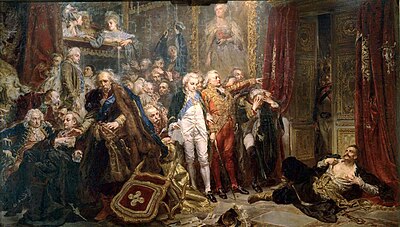Tadeusz Rejtan: Difference between revisions
m robot Adding: be-x-old:Тадэвуш Рэйтан |
I tried to correct the article for style & grammar which turned into a rather radical rewrite (with pretty few changes in terms of contents). Feel free to revert if you don't like it. |
||
| Line 28: | Line 28: | ||
[[Image:Rejtan_Upadek_Polski_Matejko.jpg|thumb|right|400px|"Rejtan - The Fall of [[Poland]]", oil on canvas by Jan Matejko, 1866, 282 x 487 cm, [[Royal Castle in Warsaw]].]] |
[[Image:Rejtan_Upadek_Polski_Matejko.jpg|thumb|right|400px|"Rejtan - The Fall of [[Poland]]", oil on canvas by Jan Matejko, 1866, 282 x 487 cm, [[Royal Castle in Warsaw]].]] |
||
'''Tadeusz Rejtan''' ( |
'''Tadeusz Rejtan''' (or '''Tadeusz Reytan''' in Old Polish spelling) (1742 - 1780) was a [[Poland|Polish]] nobleman. He was a member of the [[confederation of Bar]] and a member of the Polish [[Sejm]] from the constituency of [[Nowogródek]] (today [[Navahrudak]], [[Belarus]]). |
||
In September 1773 Rejtan tried to prevent the legalization of the [[Partitions of Poland|first partition of Poland]] |
In September 1773, as member of the [[Partition Sejm]], Rejtan famously tried to prevent the legalization of the [[Partitions of Poland|first partition of Poland]]. He is said to have bared his chest and laid himself down in a doorway, blocking the way with his own body in a dramatic attempt to stop the other members from entering (or leaving) the chamber where the debate on the partition was being held. Despite his efforts, the partition of Poland was legalized soon afterwards. |
||
| ⚫ | After the partition Rejtan withdrew from political life. He spent the rest of his days in a small estate called Hruszówka, where he died on [[August 8]], 1780. According to tradition, he was so distressed with the loss of a part of his homeland, that he lost his senses, and as a result commited suicide. |
||
Rejtan's dramatic attempt to prevent the partition earned him lasting recognition in Poland. He was, and to the present day is being considered a shining example of a patriot. As a result, he became the subject of many works of art, poems, songs and books. The events at the Partition Sejm were most famously depicted by [[Jan Matejko]] in his 1866 painting "Rejtan - The Fall Of Poland". |
|||
| ⚫ | After the partition |
||
Tadeusz Rejtan has been remembered throughout Polish history as a shining example of patriotism. As such, he is also the protagonist of countless works of art, poems, songs and books. |
|||
Tadeusz Reytan is also a patron of the high school in Warsaw of great renown (established in 1905, the name at present: VI Liceum Ogólnokształcące im. Tadeusza Reytana). |
|||
One of the most renowned and prestigious high schools in Warsaw, the "VI Liceum Ogólnokształcące im. Tadeusza Reytana", established in 1905, is named after Tadeusz Rejtan. |
|||
{{Poland-noble-stub}} |
{{Poland-noble-stub}} |
||
Revision as of 00:31, 10 February 2009
| Tadeusz Rejtan | ||
|
| ||
| Noble Family | Rejtan | |
| Coat of Arms | Reytan 
| |
| Parents | ||
| Consorts | ||
| Children | ||
| Date of Birth | 1742 | |
| Place of Birth | ||
| Date of Death | 1780 | |
| Place of Death | ||


Tadeusz Rejtan (or Tadeusz Reytan in Old Polish spelling) (1742 - 1780) was a Polish nobleman. He was a member of the confederation of Bar and a member of the Polish Sejm from the constituency of Nowogródek (today Navahrudak, Belarus).
In September 1773, as member of the Partition Sejm, Rejtan famously tried to prevent the legalization of the first partition of Poland. He is said to have bared his chest and laid himself down in a doorway, blocking the way with his own body in a dramatic attempt to stop the other members from entering (or leaving) the chamber where the debate on the partition was being held. Despite his efforts, the partition of Poland was legalized soon afterwards.
After the partition Rejtan withdrew from political life. He spent the rest of his days in a small estate called Hruszówka, where he died on August 8, 1780. According to tradition, he was so distressed with the loss of a part of his homeland, that he lost his senses, and as a result commited suicide.
Rejtan's dramatic attempt to prevent the partition earned him lasting recognition in Poland. He was, and to the present day is being considered a shining example of a patriot. As a result, he became the subject of many works of art, poems, songs and books. The events at the Partition Sejm were most famously depicted by Jan Matejko in his 1866 painting "Rejtan - The Fall Of Poland".
One of the most renowned and prestigious high schools in Warsaw, the "VI Liceum Ogólnokształcące im. Tadeusza Reytana", established in 1905, is named after Tadeusz Rejtan.
